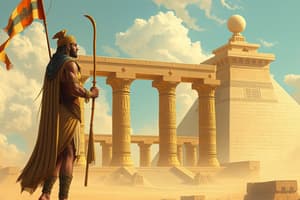Podcast
Questions and Answers
Which innovation is attributed to the Akkadian Empire's period of growth and prosperity?
Which innovation is attributed to the Akkadian Empire's period of growth and prosperity?
- The establishment of a codified legal system based on social class.
- The unification of city-states under a central government. (correct)
- The construction of ziggurats with advanced astronomical observatories.
- The development of iron tools and weapons for widespread use.
The name 'Babylon' is derived from Akkadian, what is the meaning of this name?
The name 'Babylon' is derived from Akkadian, what is the meaning of this name?
- Center of Commerce
- Door of the Gods (correct)
- Ancient Fortress
- Royal City
What is a distinctive characteristic of Hammurabi's Code compared to earlier law codes?
What is a distinctive characteristic of Hammurabi's Code compared to earlier law codes?
- It was the first law code to be written in cuneiform.
- It applied laws uniformly regardless of social standing.
- It was primarily focused on religious laws and offenses against the gods.
- It specified punishments and rules based on social class, gender, age, and profession. (correct)
The Code of Ur-Nammu, predating Hammurabi's Code, was created during the rule of which king and empire?
The Code of Ur-Nammu, predating Hammurabi's Code, was created during the rule of which king and empire?
Which military innovation is specifically associated with the Assyrians in their warfare?
Which military innovation is specifically associated with the Assyrians in their warfare?
In Mesopotamian history, which empire directly preceded the Neo-Babylonian Empire?
In Mesopotamian history, which empire directly preceded the Neo-Babylonian Empire?
Beyond law and governance, what broader contribution is attributed to Mesopotamian civilizations?
Beyond law and governance, what broader contribution is attributed to Mesopotamian civilizations?
The Hanging Gardens of Babylon are described as a Wonder of the Ancient World, but what is debated about them?
The Hanging Gardens of Babylon are described as a Wonder of the Ancient World, but what is debated about them?
Which geographical characteristic was crucial for the development of early civilizations like Egypt, Kush, and Canaan, similar to Mesopotamia?
Which geographical characteristic was crucial for the development of early civilizations like Egypt, Kush, and Canaan, similar to Mesopotamia?
What language, besides Akkadian and Babylonian, became widely used within the Assyrian Empire's administration and among incorporated groups?
What language, besides Akkadian and Babylonian, became widely used within the Assyrian Empire's administration and among incorporated groups?
How did the Nile River benefit the Egyptian civilization?
How did the Nile River benefit the Egyptian civilization?
Which was a significant characteristic of Kush's economy?
Which was a significant characteristic of Kush's economy?
What geographical feature played a crucial role in the development of civilizations in Canaan?
What geographical feature played a crucial role in the development of civilizations in Canaan?
Which factor most influenced the development of early civilizations according to the content?
Which factor most influenced the development of early civilizations according to the content?
What extended the trade connections of Kush to faraway regions?
What extended the trade connections of Kush to faraway regions?
Which ruler is credited with uniting multiple cities in Mesopotamia for the first time?
Which ruler is credited with uniting multiple cities in Mesopotamia for the first time?
What was the primary role of priests in early Mesopotamian society?
What was the primary role of priests in early Mesopotamian society?
How did Mesopotamian priests interpret the will of the gods?
How did Mesopotamian priests interpret the will of the gods?
What characterized the religious beliefs of the Mesopotamians?
What characterized the religious beliefs of the Mesopotamians?
Which Mesopotamian king is renowned for his contributions to law and codes of conduct?
Which Mesopotamian king is renowned for his contributions to law and codes of conduct?
What is the significance of scribes in ancient Mesopotamia?
What is the significance of scribes in ancient Mesopotamia?
Which empire is associated with the development of Aramaic?
Which empire is associated with the development of Aramaic?
Flashcards
Nile River flooding
Nile River flooding
Annual floods of the Nile created fertile land for agriculture in Egypt.
Kush civilization
Kush civilization
An ancient kingdom south of Egypt, reliant on Nile tributaries for trade.
Trade network
Trade network
A vast system connecting Kush to regions as far away as India and China.
Canaan geography
Canaan geography
Signup and view all the flashcards
Impact of geography
Impact of geography
Signup and view all the flashcards
Mesopotamia
Mesopotamia
Signup and view all the flashcards
Sargon of Akkad
Sargon of Akkad
Signup and view all the flashcards
Hammurabi
Hammurabi
Signup and view all the flashcards
Polytheism
Polytheism
Signup and view all the flashcards
Akkadian Empire
Akkadian Empire
Signup and view all the flashcards
Babylonian Law
Babylonian Law
Signup and view all the flashcards
Neo-Babylonians
Neo-Babylonians
Signup and view all the flashcards
Code of Hammurabi
Code of Hammurabi
Signup and view all the flashcards
Neo-Babylonian Period
Neo-Babylonian Period
Signup and view all the flashcards
Assyrian Empire
Assyrian Empire
Signup and view all the flashcards
Iron tools
Iron tools
Signup and view all the flashcards
Hanging Gardens
Hanging Gardens
Signup and view all the flashcards
Babylonian Captivity
Babylonian Captivity
Signup and view all the flashcards
Code of Ur-Nammu
Code of Ur-Nammu
Signup and view all the flashcards
Geography in Civilization
Geography in Civilization
Signup and view all the flashcards
Study Notes
Mesopotamian Civilizations
- Mesopotamian civilization emerged around 3000 BCE in the Middle East.
- Early city-states were unified by king-priests, later rulers gained power through military conquest and alliances.
- Sargon of Akkad (around 2280 BCE) was the first to unite multiple Mesopotamian cities.
- Hammurabi (around 1800 BCE) created a significant legal code.
- Mesopotamian religion was polytheistic and anthropomorphic.
- Priests initially controlled trade and land as representatives of the gods.
- Mesopotamian priests interpreted divine will through dreams, visions, and animal sacrifices (e.g., An was the father of gods in Sumer).
- Scribes' written texts provide significant insights into Mesopotamian life.
Mesopotamian Empires
- Four prominent Mesopotamian empires: Akkadian, Babylonian, Assyrian, and Neo-Babylonian.
- Sargon of Akkad established the first empire, influencing later conquerors.
- Language transitioned from Sumerian to Akkadian, then Aramaic under the Assyrians.
- Akkadians split into northern and southern factions, with Babylonians emerging from the south.
- Babylonians developed the first code of law.
- Assyrians formed a large Near Eastern empire, conquering Egypt.
- Neo-Babylonians, successors to Assyrians, were known for the Hanging Gardens and the Babylonian Captivity.
Akkadian Empire
- The Akkadian Empire experienced growth and prosperity.
- New technologies and innovations in farming and the arts flourished.
- A unified government system emerged, unifying city-states.
- The Akkadians set a precedent for future Mesopotamian empires.
Babylon
- Babylon, meaning "Door of God" in Akkadian, emerged as a civilization in the Old Babylon Period.
- Hammurabi codified laws, establishing Marduk as the chief god.
- Babylon became an influential empire, controlled by Akkadians, Assyrians, Hittites, and others.
- Independence was achieved in the Neo-Babylonian Period (7th-6th centuries BCE).
- Babylon's major rival was Assyria.
- The city fell to the Persian Empire, then to Alexander the Great.
- Hanging Gardens of Babylon, (attributed to Nebuchadnezzar II or Sennacherib), were a famous architectural wonder.
- Babylon contributed significantly to literature, science, architecture, and agriculture.
Law Codes
- Law codes were crucial for societal stability and justice systems.
- Early codes established standards of proof, penalties, and methods of judgment.
- The Code of Ur-Nammu (circa 2100 BCE) was the earliest extant written law code.
- Hammurabi's Code was more detailed and nuanced, considering factors like age, profession, gender, and social class.
- Hammurabi's Code consisted of 282 laws covering family, criminal, economic, and professional matters.
Assyrian Empire
- Assyrians emulated Sargon of Akkad's conquest.
- Military innovations included chariots and battering rams.
- The Assyrian Empire brought advanced administration and the Aramaic language to conquered regions.
- The legacy of independent city-states led to civil unrest and eventual Persian conquest.
Mesopotamia's Transformation
- Mesopotamia experienced dramatic changes in 500 years, evolving from a collection of city-states to a vast empire.
- Iron tools and weapons significantly impacted the region's development.
- The Neo-Babylonian era (90 years) is well-known for the Hanging Gardens and the Babylonian Captivity.
Geography and Civilization
- Geography played a critical role in the development of early civilizations (Egypt, Kush, and Canaan).
- The Nile River's annual flooding provided fertile land for Egypt.
- Kush's location facilitated trade.
- The Jordan River enabled agriculture in Canaan.
Studying That Suits You
Use AI to generate personalized quizzes and flashcards to suit your learning preferences.


